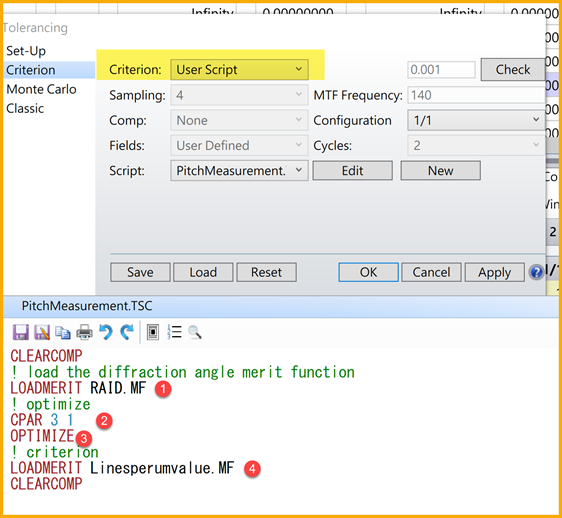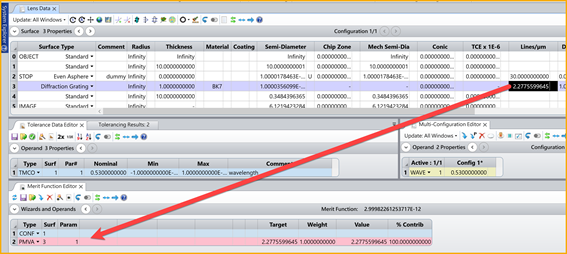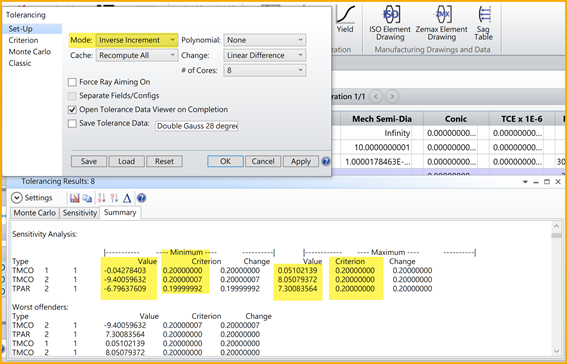The diffraction angle is determined by the measured laser wavelength, incidence angle, and the grating pitch.
Therefore, the measurement accuracy of the wavelength, incidence angle, and diffraction angle determines the pitch accuracy of the grating.
How to use the tolerance analysis function to determine the wavelength, incident angle, and diffraction angle to meet the required grating pitch accuracy?
For example, if we want to find the grating pitch d with an accuracy of 1nm, what is the required measurement accuracy for λ, θ1, and θ2?
(wavelength λ, incidence angle θ1, diffraction angle θ2, d x (sinθ2 - sinθ1) = mλ)
Ans:
The key point of this problem is, the diffraction angle θ2 is a calculated value (output value) , not a parameter (input value).
Therefore, diffraction angle θ2, in principle, can’t be a variant set in the Tolerance Data Editor.
However, the below method can solve this problem.
Please see the attached sample file.
1.The system is using a diffraction grating. The wavelength and incidence angle θ1 (Field) can be set in the system explore. The pitch of the grating is determined by the parameter Lines/um. Here we add an Even Asphere as a dummy surface. The purpose is just we want to take the 2nd Oder Term as a dummy parameter for diffraction angle θ2, which we will use later.

2.We can use multi-configuration editor to call the wavelength and field value we set in the System Explorer, and define the value in the Tolerance Data Editor by operant TMCO. For the diffraction angle θ2, we can use TPAR to call the dummy parameter we set in step1. The dummy parameter doesn’t have the meaning of diffraction angle θ2 right now, it will be connected later.

3.
Use the tolerancing criterion as User Script.

In this User Script, we set
- ①Load RAID.MF, which is a merit function used for optimization. The main purpose is to get the diffraction angle θ2 by using the RAID (to calculate the angle incident to the image plane).If the target of RAID is 30, the system will optimize the variant to let the diffraction angle θ2 always be 30 degrees. And then, we use PMVA to call the dummy parameter, the value is also 30 right now. We let the merit function calculate the difference between RAID and PMVA as the final target of the optimization. Later, if we give a perturbation to the dummy parameter, the target of the optimization will also automatically be changed. Therefore, the dummy parameter is connected to the diffraction angle θ2 right now.

- ② Set the Lines/um as a compensator. It also means the Lines/um will be a variant during the optimization we defined in ①. After optimization, the Lines/um will satisfy eq. d x (sinθ2 - sinθ1) = mλ, where wavelength λ, incidence angle θ1, diffraction angle θ2 are the values we defined in the Tolerance Data Editor.
- ③ Run optimization by OPTIMIZE
- ➃ Load Linesperumvalue.MF. Only the Lines/um is defined in this merit function file. This value will be the criterion of tolerancing.

4 Just run the Inverse Increment, for example, with Increment=0.2, we can find the required measurement accuracy for λ, θ1, and θ2 if the Line/um has accuracy of 0.2.

In conclusion, the key point of this problem is, the diffraction angle θ2 is a calculated value (output value) , not a parameter (input value).
If you want to set this kind of calculated value (output value) to be a parameter (input value) in the tolerance analysis, you should define this calculated value to the merit function and optimize the system. Next is to define a dummy parameter as an input value that can add a perturbation value in the Tolerance Data Editor. Let the difference between the original merit function value and the dummy parameter be the new target of the optimization.
This method can be used for various purposes other than diffraction angle measurement (or rather, grating pitch measurement). For example, it could be used for tolerance analysis of devices such as an ellipsometer, which measures the light that passes through and comes out of a sample to investigate the characteristics of the sample.

